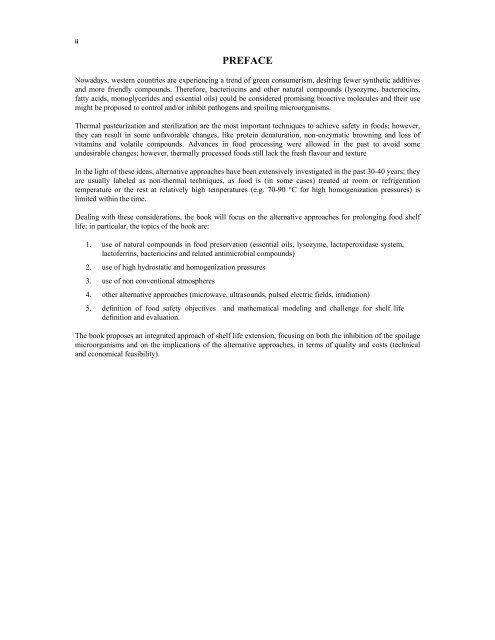application of alternative food-preservation - Bentham Science
application of alternative food-preservation - Bentham Science
application of alternative food-preservation - Bentham Science
Create successful ePaper yourself
Turn your PDF publications into a flip-book with our unique Google optimized e-Paper software.
ii<br />
PREFACE<br />
Nowadays, western countries are experiencing a trend <strong>of</strong> green consumerism, desiring fewer synthetic additives<br />
and more friendly compounds. Therefore, bacteriocins and other natural compounds (lysozyme, bacteriocins,<br />
fatty acids, monoglycerides and essential oils) could be considered promising bioactive molecules and their use<br />
might be proposed to control and/or inhibit pathogens and spoiling microorganisms.<br />
Thermal pasteurization and sterilization are the most important techniques to achieve safety in <strong>food</strong>s; however,<br />
they can result in some unfavorable changes, like protein denaturation, non-enzymatic browning and loss <strong>of</strong><br />
vitamins and volatile compounds. Advances in <strong>food</strong> processing were allowed in the past to avoid some<br />
undesirable changes; however, thermally processed <strong>food</strong>s still lack the fresh flavour and texture<br />
In the light <strong>of</strong> these ideas, <strong>alternative</strong> approaches have been extensively investigated in the past 30-40 years; they<br />
are usually labeled as non-thermal techniques, as <strong>food</strong> is (in some cases) treated at room or refrigeration<br />
temperature or the rest at relatively high temperatures (e.g. 70-90 °C for high homogenization pressures) is<br />
limited within the time.<br />
Dealing with these considerations, the book will focus on the <strong>alternative</strong> approaches for prolonging <strong>food</strong> shelf<br />
life; in particular, the topics <strong>of</strong> the book are:<br />
1. use <strong>of</strong> natural compounds in <strong>food</strong> <strong>preservation</strong> (essential oils, lysozyme, lactoperoxidase system,<br />
lact<strong>of</strong>errins, bacteriocins and related antimicrobial compounds)<br />
2. use <strong>of</strong> high hydrostatic and homogenization pressures<br />
3. use <strong>of</strong> non conventional atmospheres<br />
4. other <strong>alternative</strong> approaches (microwave, ultrasounds, pulsed electric fields, irradiation)<br />
5. definition <strong>of</strong> <strong>food</strong> safety objectives and mathematical modeling and challenge for shelf life<br />
definition and evaluation.<br />
The book proposes an integrated approach <strong>of</strong> shelf life extension, focusing on both the inhibition <strong>of</strong> the spoilage<br />
microorganisms and on the implications <strong>of</strong> the <strong>alternative</strong> approaches, in terms <strong>of</strong> quality and costs (technical<br />
and economical feasibility).

















